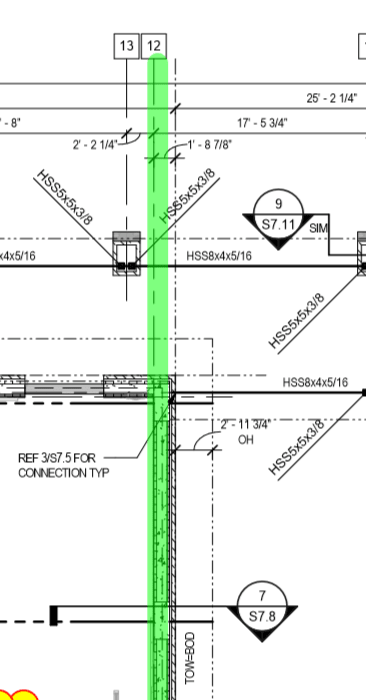@BAretired
The following information is provided in the general notes section of the plans. I believe the 1st 5 notes are the most applicable to this situation:
1.)ALL ROOF FRAMING TOP CHORD EXTENSIONS OF STEEL JOIST SHALL BE DESIGNED BY THE JOIST ENGINEER FOR 45 PSF TOTAL, 20 PSF LIVE
UNIFORM GRAVITY LOADING, AND 75 PSF WIND UPLIFT (TYPICAL ALL TOP CHORD EXTENSIONS UNO).
2.)JOIST ENGINEER SHALL DESIGN AND PROVIDE JOIST SYSTEMS WITH CANTILEVERED “JOIST SUBSTITUTE” JOISTS FOR ALL CONDITIONS SHOWN ON
THE FRAMING PLANS, EVEN IF THE BACKSPAN LENGTHS ARE LESS THAN THE UNSUPPORTED CANTILEVERED LENGTHS AND EVEN IF THERE IS A
DEVIATION FROM SJI DEFAULT STANDARDS. THE CONTRACTOR SHALL INCLUDE ALL COSTS ASSOCIATED WITH THIS REQUIREMENT IN THE
PROPOSAL. THE JOIST ENGINEER SHALL DETERMINE THE REACTIONS AT JOIST SUBSTITUTE JOISTS SUPPORT POINTS AND PROVIDE SUFFICIENT
VERTICAL RESISTANCE (UP AND DOWN) IN JOIST CONNECTIONS AND IN OTHER JOIST MEMBERS THAT SUPPORT JOIST SUBSTITUTE JOISTS.
3.)ROOF JOIST SUPPORTING ROOFTOP MECHANICAL EQUIPMENT (RTU'S OR OTHERWISE) SHALL BE DESIGNED BY THE JOIST ENGINEER TO SUPPORT
THE INDICATED ADD-LOADS, AS DEFINED IN THE SJI CODE OF STANDARD PRACTICE FOR STEEL JOIST AND JOIST GIRDERS, PLUS A UNIFORM LOAD OF
45 PSF TOTAL LOAD (20 PSF LIVE LOAD). THE MAXIMUM DEFLECTION OF ANY ROOF JOIST SHALL BE L/240 UNDER TOTAL LOAD AND L/360 UNDER LIVE
LOAD. LOADINGS FOR MECHANICAL EQUIPMENT ARE BASED ON THE UNIT(S) SHOWN ON THE STRUCTURAL DRAWINGS. ANY CHANGES IN TYPE, SIZE,
WEIGHT OR NUMBER OF UNIT(S) SHALL BE REPORTED TO THE ARCHITECT PRIOR TO FABRICATION OR INSTALLATION OF STRUCTURAL MEMBERS OR
MECHANICAL EQUIPMENT.
4.)UNLESS INDICATED OTHERWISE ON THE DRAWINGS, WHERE JOISTS ARE SUPPORTING WALL LOADING, THE ADDITIONAL LOAD THE JOISTS ARE
REQUIRED TO SUPPORT SHALL BE DETERMNED BY THE JOIST ENGINEER BASED ON THE FOLOWING ASSUMED WALL LOADING:
A. MASONRY VENEER: 39 PSF X HEIGHT OF WALL SUPPORTED
B. CFMF WALL: 12 PSF X HEIGHT OF WALL SUPPORTED
C. CMU WALL: 75 PSF X HEIGHT OF WALL SUPPORTED
5.)THE JOIST GIRDERS SHALL BE DESIGNED AS A SIMPLE SPAN WITH THE UNFACTORED JOIST REACTIONS INDICATED BY THE JOIST GIRDER
DESIGNATION (DEAD LOAD AND LIVE LOAD).
STEEL JOISTS SHALL CONFORM TO THE REQUIREMENTS OF THE STEEL JOIST INSTITUTE STANDARD SPECIFICATIONS FOR OPEN WEB JOISTS.
MATERIAL SHALL BE DOMESTIC STEEL WITH ANGLES FOR BOTTOM CHORDS. BRIDGING SHALL BE PROVIDED FOR ALL JOISTS IN ACCORDANCE WITH
SJI REQUIREMENTS.
METAL ROOF DECK SHALL BE PROVIDED IN ACCORDANCE WITH THE PROJECT SPECIFICATIONS AND AS INDICATED ON THE PLANS. METAL ROOF DECK
SHALL BE ATTACHED TO SUPPORTING MEMBERS PER THE PROJECT SPECIFICATIONS.
ALL JOISTS SHALL HAVE BOTTOM CHORD UPLIFT BRIDGING AT EACH END AND BE DESIGNED FOR 35 POUNDS PER SQUARE FOOT NET UPLIFT.
FOR ALL ROOF PENETRATIONS THROUGH METAL DECK 8” OR LARGER PROVIDE AN L3X3X1/4 AROUND THE OPENING AND FRAME ALL SIDES (EXCEPT
WHERE OPENING EDGE IS WITHIN 1'-0” OF ANOTHER FRAMING MEMBER - JOIST/BEAM) WITH A STRUCTURAL MEMBER. FRAMING NOT REQUIRED FOR
ROOF OPENINGS SMALLER THAN 8”.
THE ROOF DECK IS STANDING SEAM AND WILL NOT BRACE THE TOP CHORD OF THE BAR JOISTS. EXTRA BRIDGING IS SHOWN ON THE PLAN, BUT THE
JOIST MANUFACTURER IS RESPONSIBLE FOR VERIFYING BRIDGING SPACING AND DESIGNING THE TOP CHORD AS REQUIRED FOR THE BRACING
SPACING.
LOCATE CONCENTRATED LOADS ON JOISTS AT PANEL POINTS. PROVIDE ANGLE WEB MEMBERS TO CREATE INTERMEDIATE PANEL POINTS AS
REQUIRED. MANUFACTURER SHALL DIRECT INSTALLER AS TO METHOD OF INSTALLATION AND MATERIAL REQUIRED. JOISTS AND JOIST GIRDERS
SHALL BE SHOP REINFORCED FOR ALL LOADS PROVIDED ON DRAWINGS. FIELD REINFORCING SHALL BE PROVIDED AS DETAILED ON THE DRAWINGS.
METAL ROOF DECK IS DESIGNED FOR 3 SPAN CONDITIONS. IT IS THE RESPONSIBILITY OF THE DECK SUPPLIER TO ADJUST THE THICKNESS (GAUGE)
OF THE ROOF DECK AT SINGLE OR DOUBLE SPAN CONDITIONS AS REQUIRED BY THE STEEL DECK INSTITUTE.
PROVIDE SUPPORT FOR EDGES OF DECK WHETHER SHOWN ON THE DRAWINGS OR NOT.
UNLESS INDICATED OTHERWISE ON THE DRAWINGS, WHERE BRACES ARE SHOWN TO ATTACH TO THE ROOF JOIST, THE ENGINEER SHALL ASSUME
THE LOAD IN AXIAL LOAD IS EQUAL TO A COMPRESSION OR TENSION SERVICE LEVEL WIND LOAD OF 2 KIP.

